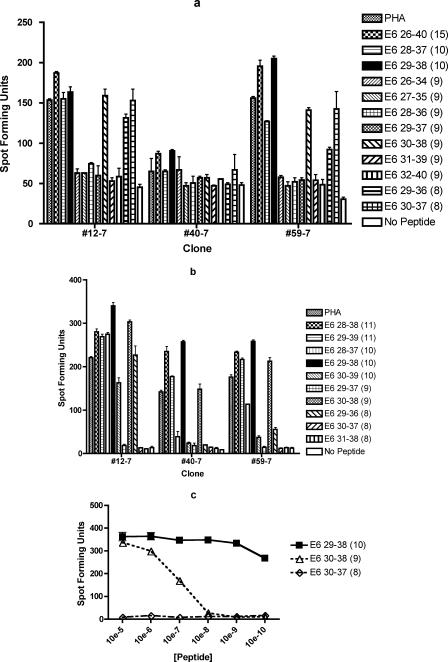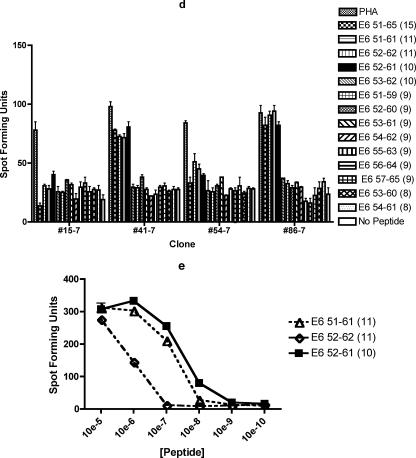FIG.2.
ELISPOT assays demonstrating that the shortest and optimal peptide for subject 7's dominant epitope is E6 29-38 and that the miminal among equally effective peptides of her subdominant epitope is E6 52-61. The numbers in parentheses indicate peptide lengths in amino acids. The bars represent standard errors of the means. (a) Two of three T-cell clones tested demonstrated the highest number of spot-forming units with E6 29-38 among a number of peptides tested including two 8-mers (E6 29-36 and E6 30-37), seven overlapping 9-mers covering the E6 26-40 region, two 10-mers (E6 28-37 and E6 29-38), and one 15-mer (E6 26-40). The experiment was done in duplicates. (b) Comparison of the E6 28-38 11-mer, E6 29-39 11-mer, E6 28-37 10-mer, E6 29-38 10-mer, E6 30-39 10-mer, E6 29-37 9-mer, E6 30-38 9-mer, E6 29-36 8-mer, E6 30-37 8-mer, and E6 31-38 8-mer revealed that the optimal peptide of minimum length is likely to be the E6 29-38 10-mer. The experiment was done in triplicates. (c) Comparison of the E6 29-38 10-mer, E6 30-38 9-mer, and E6 30-37 8-mer, ranging from 10−5 M to 10−10 M, confirmed the optimal peptide of minimum length to be the E6 29-38 10-mer peptide. The experiment was done in duplicates, and the results of one representative clone (#59-7) out of two clones tested are shown. (d) Two of four T-cell clones tested demonstrated the most number of spot-forming units with E6 52-61 among a number of peptides tested including two 8-mers (E6 53-60 and E6 54-61), seven overlapping 9-mers covering the E6 51-65 region, two 10-mers (E6 52-61 and E6 53-62), two 11-mers (E6 51-61 and E6 52-62), and one 15-mer (E6 51-65). The experiment was done in duplicates. (e) Comparison of the E6 51-61 11-mer, E6 52-62 11-mer, and E6 52-61 10-mer, ranging from 10−5 M to 10−10 M, confirmed that the minimal peptide between the two optimal peptides is the E6 52-61 10-mer peptide. The experiment was done in triplicates, and the graph of one representative clone (#86-7) out of two clones tested is shown.


